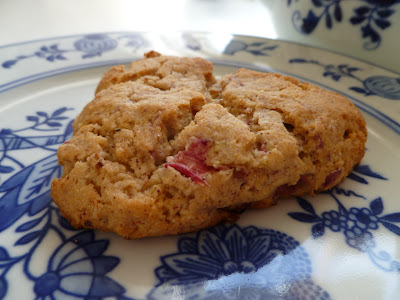This trip, I sneaked in my own traveling companion of a batch of no knead bread dough, made with Lonesome Whistle Farm red fife and rye flour. The slowly fermenting culture rode along happily in a large tupperware container, basking in the faint warmth of sun breaks as we played in the marbled sand.
When we arrived at Yachats in the late afternoon, I plopped my friend into a loaf pan to rest as we explored the cottage and discovered a newt in a backyard stream. By dinnertime, the fragrance of yeasty bread enveloped our cottage, and even though the loaf was a bit mangled by the sticky pan and dull bread knife, it tasted delicious. Replete with the virtues of patience, adaptability, and ultimately good taste, this dough makes the perfect traveling companion.
Traveling Companion Bread
based on Jim Lahey's No Knead Bread
1 cup rye flour2 cups whole wheat flour (such as Lonesome Whistle Farm red fife flour)
1 1/2 tsp salt
1/4 tsp yeast
1 1/2 cups water
coarse corn meal for coating the dough
1. The evening before your trip, or early that morning, combine the flour, yeast and salt in a large bowl. Add 1 1/2 cups water and stir until blended (a dough whisk is handy for this). Dust a large tupperware container with corn meal, put the dough in, and seal loosely. Let the dough rest at least 12 hours, preferably about 18, and preferably at about 70 degrees, but don't worry too much about temperature fluctuations during your trip.
2. Hopefully when you arrive at your destination, your dough will have doubled in size and become speckled with bubbles. Check whether there is a 6- to 8-quart heavy covered pot (cast iron, enamel, Pyrex or ceramic) available for baking your bread according to Jim Lahey's method. Otherwise, locate a loaf pan or baking sheet.
Lightly flour a work surface and place the dough on it; sprinkle it with a little more flour and fold it over on itself once or twice. Place it in an oiled loaf pan, shape it into a loaf on a baking sheet, or form it into a ball on a floured cotton towel. Cover with another cotton towel and let rise again, ideally for about 2 hours, but it will still be delicious if given less time.
3. About an hour before dinner, start heating your oven to 450 degrees. If using, put your heavy pot in the oven to preheat. When the oven is hot, put your bread in to bake. If using a preheated pot, carefully slide your hand under the towel and turn the dough over into pot; it may look like a mess, but that is O.K. Shake the pan once or twice if the dough is unevenly distributed; it will straighten out as it bakes. Cover with a lid and bake 30 minutes, then remove the lid and bake another 15 to 30 minutes, until the loaf is beautifully browned. When you tap it with your fingernail it should sound hollow. Cool on a rack or devour immediately.


















